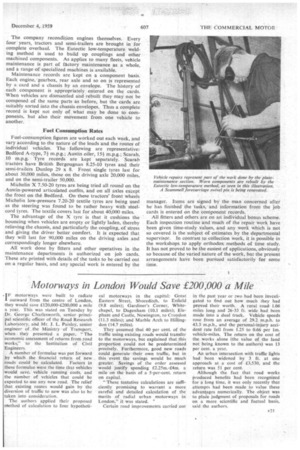Motorways in London Would Save £200,000 a Mile
Page 65

If you've noticed an error in this article please click here to report it so we can fix it.
.IF motorways were built to radiate
outward from the centre of London, they would save £120,000-£200,000 a mile a year. This was stated on Tuesday by Dr. George Charlesworth, senior principal scientific officer of the Road Research Laboratory, and Mr. J. L. Paisley, senior engineer of the Ministry of Transport, when they presented a paper, "The economic assessment of returns from road works," to the Institution of Civil Engineers.
A number of formulae was put forward by which the financial return of new roads could be calculated. Factors in these formulae were the time that vehicles would save, vehicle running costs, and the number of vehicles that could be expected to use any new road. The relief that existing routes would gain by the diversion of traffic to new was also to be taken into consideration.
The authors applied their proposed method of calculation to four hypotheti
cal motorways in the capital: Great Eastern Street, Shoreditch, to Enfield (9.8 miles); Gardiner's Corner, Whitechapel, to Dagenham (10.1 miles); Elephant and Castle, Newington, to Croydon (11.3 miles); and Marble Arch to Hillingdon (14.7 mites).
They assumed that 40 per cent. of the traffic using existing roads would transfer to the motorways, but explained that this proportion could not be predetermined precisely. Furthermore, good new roads could generate their own traffic, but in this "event the savings would be much greater. Savings of the order assessed would justify spending £2,25m.44m. a mile on the basis of a 5-per-cent. return on capital.
"These tentative calculations are sufficiently promising to warrant a more careful and detailed calculation of the merits of radial urban motorways in London," it was stated. • Certain road improvements carried out
in the past year or two had been investigated to find out how much they had proved their worth. A rural road1.06 miles long and 26-33 ft, wide had been made into a dual track. Vehicle speeds rose from an average of 29.2 m.p.h. to 43.3 m.p.h., and the personal-injury accident rate fell from 1.25 to 0.66 per lm. vehicle-miles. The return on the cost of the works alone (the value of the land not being known to the authors) was 13 per cent. a year.
An urban intersection with traffic lights had been widened by 3 ft. at one approach at a cost of £3,530, and the return was 51 per cent.
Although the fact that road works produced benefits had been recognized for a long time, it was only recently that attempts had been made to value these advantages numerically. The object was to pia& judgment of proposals for roads on a more scientific and factual basis, said the authors.
























































































































